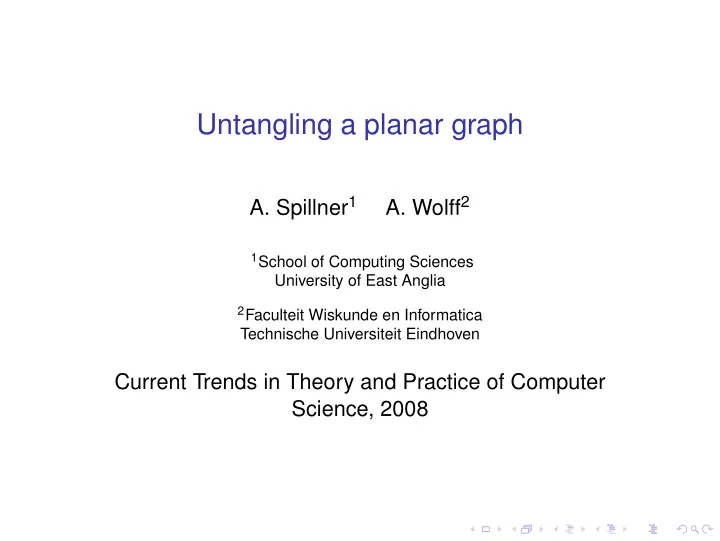

Untangling a planar graph A. Spillner 1 A. Wolff 2 1 School of Computing Sciences University of East Anglia 2 Faculteit Wiskunde en Informatica Technische Universiteit Eindhoven Current Trends in Theory and Practice of Computer Science, 2008
Outline Statement of the problem and previous work The basic idea for our lower bound construction Our results Concluding remarks
Geometric graphs A graph G = ( V , E ) with a fixed straight line drawing δ in the plane.
Crossing edges Two edges that share a point that is not an endpoint of both.
Untangling a geometric graph Move vertices to new positions to get rid of all crossing edges. v u v u
Fixed vertices Vertices that are not moved during the untangling process are called fixed . v u v u
Restriction to planar graphs Clearly, not every geometric graph can be untangled. So, we assume that G is planar, that is, there exists a drawing without crossing edges.
Statement of the problem ◮ Given a straight line drawing δ of a planar graph G we define fix ( G , δ ) as the maximum number of vertices that can be kept fixed when untangling δ . ◮ Given a planar graph G we define fix ( G ) as the minimum of fix ( G , δ ) over all possible straight line drawings δ of G .
Statement of the problem ◮ Goal Give upper and lower bounds on fix ( G ) in terms of the number n of vertices of G . ◮ Intuitively What is the number of vertices we can always keep fixed no matter what planar graph on n vertices we are given and how “bad” the drawing of it is?
Previously known lower bounds ◮ Paths and cycles (Pach and Tardos 2002): √ Ω( n ) ◮ Trees (Goaoc et al. 2007): √ Ω( n ) ◮ General planar graphs (Goaoc et al. 2007, Verbitsky 2007): 3
Previously known upper bounds ◮ Cycles (Pach and Tardos 2002): O (( n log n ) 2 / 3 ) ◮ General planar graphs (Goaoc et al. 2007) √ O ( n )
Making our live easy For the lower bound construction we will assume that the given planar graph G is triangulated , that is, any additional edge will make G non-planar.
The given drawing 9 10 13 12 11 5 7 6 4 2 3 1 8
Guiding our construction 13 12 11 9 10 2 4 5 3 6 1 8 7 A path with no chords on one side.
Back to the given drawing 9 10 13 12 11 5 7 6 4 2 3 1 8
Untangling the path 9 10 13 12 11 5 7 4 2 6 3 1 8
Untangling the chords 9 10 13 12 11 4 5 2 6 3 7 1 8
Drawings with star-shaped boundary (Hong and Nagamochi 2006)
The resulting untangled drawing 13 11 12 10 4 5 2 9 6 8 3 7 1 √ For a path with l vertices we can keep Ω( l ) vertices fixed.
Finding suitable long paths in the given graph We have ◮ a vertex u of high degree, u or ◮ a large diameter (and then using Schnyder Woods).
Our results Lower bounds: ◮ General planar graphs: � log n Ω( log log n ) ◮ Outerplanar graphs: √ Ω( n ) Upper bound: ◮ Outerplanar graphs: √ O ( n )
Concluding remarks Two main results: ◮ Asymptotically tight lower and upper bounds for the class of outerplanar graphs. ◮ The path construction outlined in this talk is a main building block in the proof of the recently improved lower bound for general planar graphs (Bose et al. 2007), which yields √ 4 Ω( n ) .
Recommend
More recommend